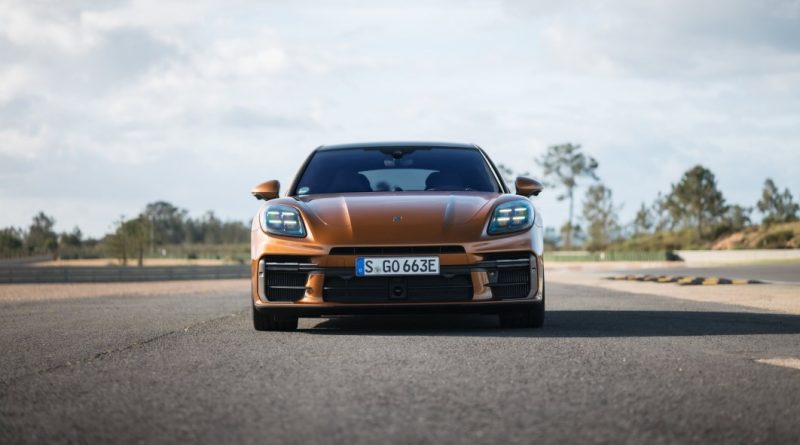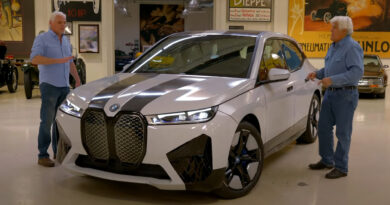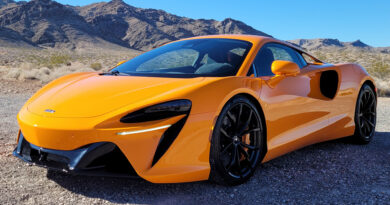2024 Porsche Panamera First Drive Review: Porsche does luxury
SEVILLE, Spain – The Panamera has been called many things. To its stewards, it is the Porsche of luxury sedans. To detractors, it’s yet another symbol of the once-great sports car builder’s diluted modern mission. To its engineers, it’s a chance to prove that the Porsche emblem represents excellence in any context, and to do so, they’re willing to do just about anything short of reinventing the wheel.
At this rate, humankind’s greatest mobility epiphany may be in jeopardy too, because the 2024 Porsche Panamera doesn’t seem to roll at all. While 2024 represents only a heavy revision of the Panamera’s fundamental platform, it’s also a culmination of a generation’s worth of engineering lessons and technological advancement at a time when electrification is doling out large helpings of both at a breakneck pace.
But the 2024 Porsche Panamera isn’t merely a technological tour-de-force. Its engineers weren’t keen to discuss ADAS or the future of self-driving. The Panamera may be a luxury conveyance, but it’s still engineered to be best appreciated from behind the wheel, no matter how enticing the upholstery on the rear split-bucket bench may be.
Houndstooth interior or not, the Panamera is not a carpet in the literal sense, but its suspension is indeed magical and the specs bear out the airborne metaphor. It’ll do 0-to-60 in about 3 seconds on the way to a top speed north of 195 mph; that’s flying, certainly. But lithe aerialist, the Panamera is not. Its wide fenders may be designed to mimic the 911’s, but with 670 horsepower and 685 pound-feet of torque, Panamera Turbo E-Hybrid might be a bit more Höllenkatze than Carrera.
Those figures may not seem far off from the last gen’s, but remember, this isn’t a clean-sheet redesign. The base and E-Hybrid models are still built around a twin-turbo V6, while the Turbo E-Hybrid utilizes a V8 alongside its hybrid components. The V8’s turbos are single-scroll units now rather than twins, and the PDK now has a motor inside its housing, but the general layout of things hasn’t changed all that much.
The real story here is Porsche’s new suspension — the rare bit of wizardry that actually makes the complexity of an adaptive suspension seem worthwhile. We’re talking standard dual-chamber air suspension with the option to upgrade to the Turbo E-Hybrid and its Active Ride, which ventures into no-anti-roll-bars levels of silliness.
Anti-roll bars — aka stabilizer bars, sway bars, or “that stupid thing I have to drop the cradle to install” — create a physical link between the opposing corners of a suspension. They reduce body roll by tying the motions of the two corners together. The stiffer the anti-roll bar, the less independently (or the more like a solid axle) your suspension will behave.
In other words, anti-roll bars inherently restrict the very advantages that make independent suspension designs worthwhile in the first place. But without anti-roll bars (or an equivalent stand-in), you end up with a smooth but floaty — and decidedly un-Porsche-like — ride.
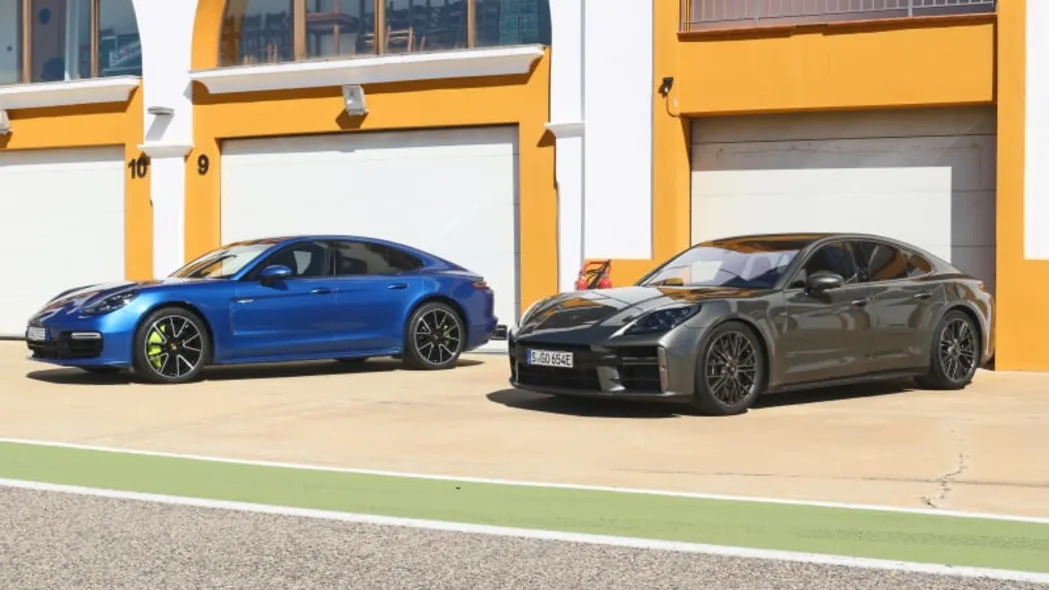
Fortunately, Porsche has Porsche money, and with Porsche money you can afford to replace anti-roll bars with something superior. What most cars rely on their stabilizer bars for, Porsche’s Active Ride can do better, and we have the Panamera’s new onboard 48-volt electrical architecture to thank for it.
What does electrical architecture have to do with suspension design? Well, to implement a system that can independently control the air springs and hydraulic dampers simultaneously while also simulating the effects of an anti-roll bar, you need a lot of sensors, along with the bandwidth and computing power to crunch all the data they produce. Porsche’s new 48-volt standard not only provides the necessary bandwidth, but doubles as a weight-saving measure of sorts. By increasing the voltage (what amounts to the “speed” of electricity), the Panamera’s various sensors and modules can talk to each other at lower latencies while using thinner conductors. Like paint, wiring harnesses add weight.
With this upgrade, Porsche’s electrical engineers designed a system to work in what might as well be real-time. The result is a computer that knows what you’re doing before you’re fully committed to doing it, allowing it to act both reactively and predictively. With a suspension this smart and versatile, the Panamera joins a rare niche of high-performance luxury cars that don’t have anti-roll bars at all. McLaren made waves with a hydraulic setup that accomplished the same thing in the MP4-12C and has evolved it since. Rivian’s trucks employ something similar, as do some Mercedes offerings and the Ferrari Purosangue.
But Porsche wasn’t content with simply aping the performance of an uncompromised steel suspension. Porsche money, remember? The Turbo E-Hybrid’s Active Ride takes things a step further by actively pitching and rolling the chassis to counter its natural body motions. Ever driven a car that leans into a corner or noses down while accelerating?
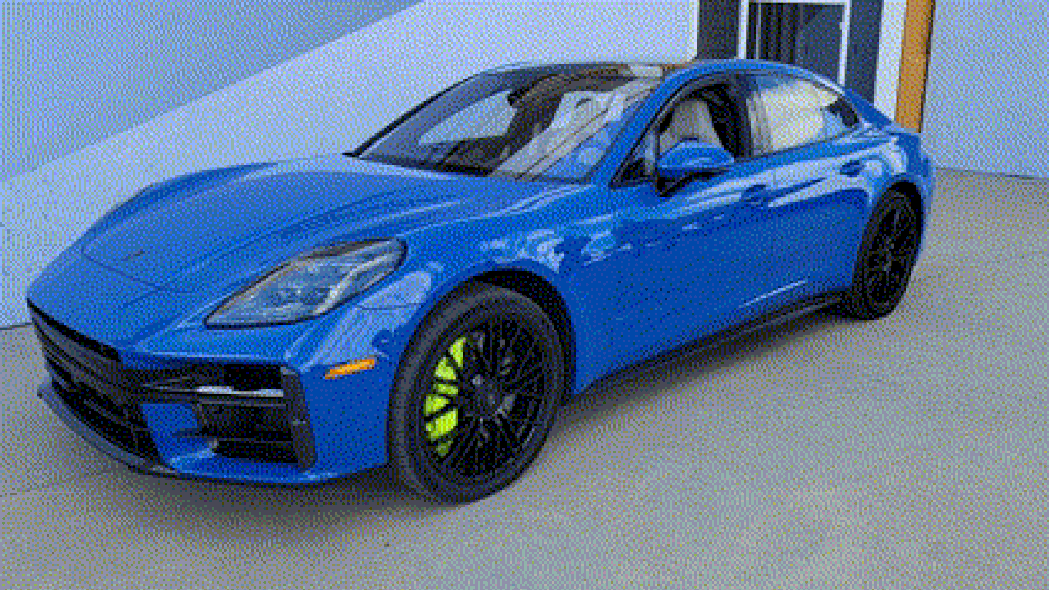
Yep, it’s as spooky as it sounds, especially the pitch control, which will bring the Panamera’s nose up during hard braking to counter the natural dive of the body. The sensation is similar to the way a power boat comes off a smooth plane when the throttles are suddenly cut. The eeriness is amplified in a panic stop because it completely changes the way your body experiences the deceleration. You hit the belts with more force and you feel less of a downward tug on your legs due to the utter absence of brake dive.
These features are disabled in the Turbo’s sporty drive modes for a good reason, but we were allowed to play around with them during our lead-follow session at Circuito Monteblanco here in western Spain. If the experience sounds bizarre, seeing it in action is even nuttier. Riding behind a car with both features activated is like watching the early build of a racing sim where somebody inverted the animations from the physics engine. Up is down. Left is right. Porsche is luxury?
Maybe, but it must first be fast. The other half of our track session was spent doing more track-appropriate things, like seeing just how quick this sled can go. The Turbo E-Hybrid may accelerate like a sports car, but it sure doesn’t brake like one. That’s not a knock against the hardware, mind you; those big clampers do the job, but the way Porsche managed to hide the Panamera’s heft at the far edges of your perception makes it tricky to get a sense of the car’s true scale. I learned this the spicy way after finding a bit of speed deeper in my session and consequently blowing the ensuing braking zone by about 20 feet.
From behind the wheel, it’s easy to forget that a thousand pounds separate the standard Panamera and this 670-horsepower brute, and thanks to its low hip point, it feels every bit the part of a sporty GT tucked behind the 911 leading our session. No attempt has been made at a “commanding” seating position, mostly for the better, but it does make it all the more difficult to mentally acclimate to the big Porsche’s incongruently petite attitude.
The suspension is still hard at work, but rather than trying to mute the car’s responses to the outside world, it’s doing its best to communicate them. The result is a mixed bag. Isolation is a key component of a luxurious ride; trying to retroactively engineer “feel” back into the design without compromising that is challenging.
The result (such as it is) manifests as road noise on the street and tangible communication through some of the Panamera’s touch points on track, but with everything going on between the driver and the pavement, you’re left to rely on your hips and shoulders more than your hands for accurate feedback. Getting a feel for the rear end is easy, and even with stability control on, it doesn’t balk at a little trail braking, and it responds to lift with predictable linearity.
But it’s still just so darned heavy. When I compared it to that quasi-aforementioned Charger Hellcat, that was a bit unfair to the big Dodge. The Charger widebody checks in at around 4,600 pounds; the Turbo E-Hybrid weighs as much as a Hellcat with the rest of your nuclear family already belted in. (We don’t have an official figure for 2024. The current Turbo S E-Hybrid is almost 5,300.) But unlike the Charger, which possesses the sort of gravitas normally reserved for the likes of Larry the Cable Guy, the Panamera leads with a level of refinement and poise that overpromises in the other direction. Consequently, the Turbo’s 670-odd horsepower just doesn’t feel all that fast, even with 331 pound-feet of that powertrain’s torque coming from electric motors. Pure EV acceleration has spoiled us almost as much as Hellcats have.
On the street, we get to sample the standard Panamera and Panamera 4; a thousand pounds lighter and with only about half the power, they’re quite a departure from what we got to toy with at Monteblanco. As it turns out, though, they’re far better suited to the Spanish countryside, which seems utterly devoid of anything resembling a straightaway.

The standard car lacks the Turbo E-Hybrid’s Active Ride and all the nifty pitch and roll mitigation features that come with it, but it still rides on air. There’s a distinct progression in firmness as you dial it up through the Sport and Sport Plus drive modes. For a pleasant cruise through the country, the standard Auto mode will do just fine; even Sport Plus rarely feels punishing. Porsche is luxury?
The twin-turbo V6 makes 348 horsepower and 368 lb-ft of torque; nothing to write home about, but more than adequate. Porsche says the Panamera 4 will hit 60 in 4.7 seconds, while the standard RWD model needs 5.0 flat — both plenty impressive considering the physics involved. There will be more powertrains as time goes on, with two additional mid-range hybrids coming almost immediately. With 536 hp and 553 lb-ft, the 4S E-Hybrid looks to be the sweet spot. The Turbo E-Hybrid will eventually be dethroned by an S, but we don’t yet know how much power it’ll offer.
This will be the final Panamera on this chassis, and if Porsche has left anything on the table, I can’t readily identify it. The next Panamera will be electric. Perhaps not exclusively, but the platform’s engineers have already openly acknowledged the inevitability. By default, this is the most advanced ICE-based sedan Porsche has ever built, and due in no small part to its engineers’ dedication to ride quality over outright performance, the most luxurious sedan the brand has ever built. It’ll probably be the most expensive too, but we’re still a few weeks away from learning final pricing. Regardless, Porsche has demonstrated a fundamental understanding of the assignment. Whether the brand’s fanatics will apply the same rubric is another matter entirely.
Despite the limitations of its nearly decade-old platform, the Panamera’s engineers have managed to unlock even more performance potential without letting it stray from its luxury mission. More than that, Porsche managed to accomplish this by decidedly luxurious — and dare I say, characteristically German — means. By that, I mean expensive, high-tech engineering. OK, then. So Porsche really is luxury.

